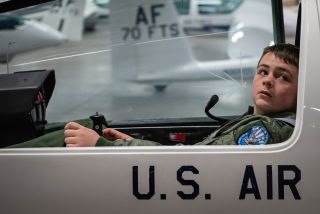Reaching Out to a Remote World
- Share via
On a recent Monday morning, 8-year-old Dov Shestack is off to Culver City, backpack full of snacks and a change of clothes.
After an hour of occupational therapy--swinging on swings, balancing on balls, writing the letters of his name in modeling clay--it’s into the car again, down miles of clogged freeways to Encino, where he spends 1 1/2 hours putting together puzzles, learning and repeating the names of rabbits, numbers and other sundry objects.
On another day, it’s Culver City for OT, then over to Canoga Park for speech therapy. There--with the help of much praise and many gummy worms--Dov is encouraged to move his tongue and lips into the right positions to say words such as “dog” and “car.”
Dov, a dark-lashed boy with a quizzical expression, has autism. And his parents are trying everything they can to help make him better.
His mother, Portia Iversen, is even busier than Dov.
As she drives, she schedules plane flights on her headset and talks about the science of autism and the group, Cure Autism Now, that she and her husband, Jon Shestack, founded in 1995.
She looks tired, and no wonder: She was up all night reading requests from scientists for money for autism research.
Eight years ago, Iversen, an Emmy Award-winning art director, was a screenwriter working on the sitcom “Blossom.” Shestack was a successful producer.
Everything changed in 1994 when they learned that their firstborn son had autism.
“I can remember nights, after he got the diagnosis, sitting by his crib having this realization over and over again . . . that he’s in the grip of this terrible disease that is basically stealing away his mind,” Iversen says. “It is the worst thing you can imagine.”
Worse, still, was the discovery that Dov didn’t respond very well to a mainstream autism therapy called “applied behavior analysis,” and the realization that there wasn’t much research going into either causes or therapies for autism. Iversen and Shestack started Cure Autism Now in an effort to change that.
While many autism groups focus on getting services for autistic kids, Cure Autism Now’s focus is on improving the science.
Early on, the group commissioned a study that assessed the cost of autism as $13 billion annually in services and lost wages. (Estimates that include caring for adults run even higher, Shestack says.)
“We sent a letter to the National Institutes of Health, in which we told them what it cost--and they sent back a letter saying, ‘Yes, autism is a terrible disease, and by the way, did you know that it costs 13 billion annually?’ ” says Shestack, visibly irritated.
The group also spearheaded the effort for legislation for increased federal autism funding. In October, President Clinton signed into law a bill that will provide $40 million a year for five years for autism research. It will set up “centers of excellence” for studying causes and treatments for autism as well as other centers for tracking the disorder. It will also fund an awareness campaign aimed primarily at doctors.
The group also holds conferences and awards grants ($2.5 million last year) to further research into autism. It has amassed a collection of DNA samples from more than 400 families with at least two members with autism to be used for research purposes. The samples can be accessed by any research group in the world.
The group’s use of the word “cure” has riled some people in the autism community, including some people diagnosed with high-functioning autism who feel they should be accepted, not “cured.” (One tongue-in-cheek autism Web site advertises a fake organization called “Cure All NeuroTypicals,” or CAN’T.)
“Other groups think of us as the ‘yuppie’ autism group--but we are also oriented toward parents,” says Shestack. Cure Autism Now, for instance, is developing an Internet database where parents can exchange information about therapies, therapists and doctors to cut down on the interminable delays in getting treatment.
Today, as Dov continues to make steady, slow progress, Shestack splits his time between Cure Autism Now and his job as a producer. Iversen devotes all her time to the organization and her family.
Her hours, these days, are taken up by fund-raising; boning up on autism science; helping review research grants at the National Institute of Mental Health; reviewing grants submitted to Cure Autism Now--and tending to Dov and her other children.
“It splinters the family--everyone is always watching Dov or working on CAN,” Iversen says. But the payoff for that effort could be huge--for Dov and other children like him.
“We see this golden opportunity,” Iversen says. “The research just hasn’t been done, and now the tools are really available: Things like genetic research have just exploded in the last 10 years.
“Today, we have the tools--we have basically an empty slate--and something is going to be found.”






